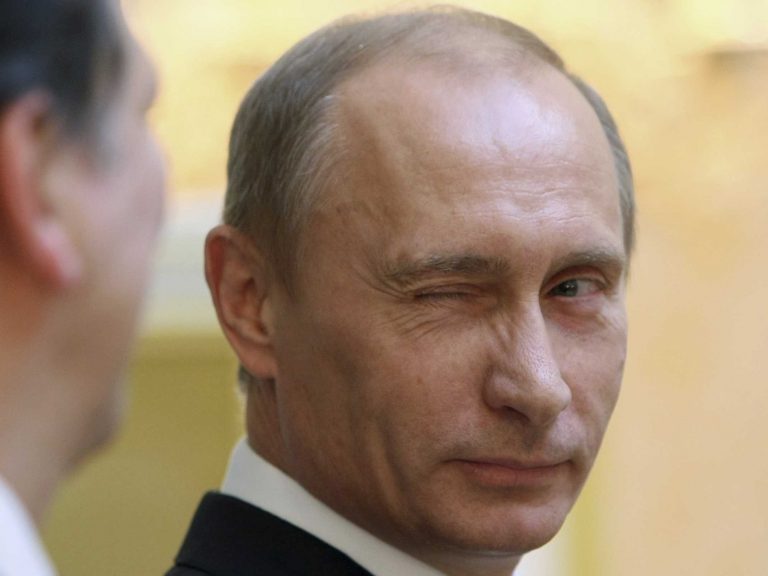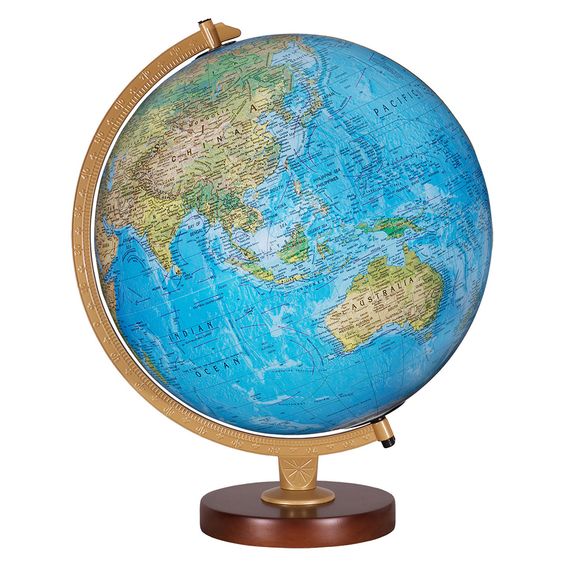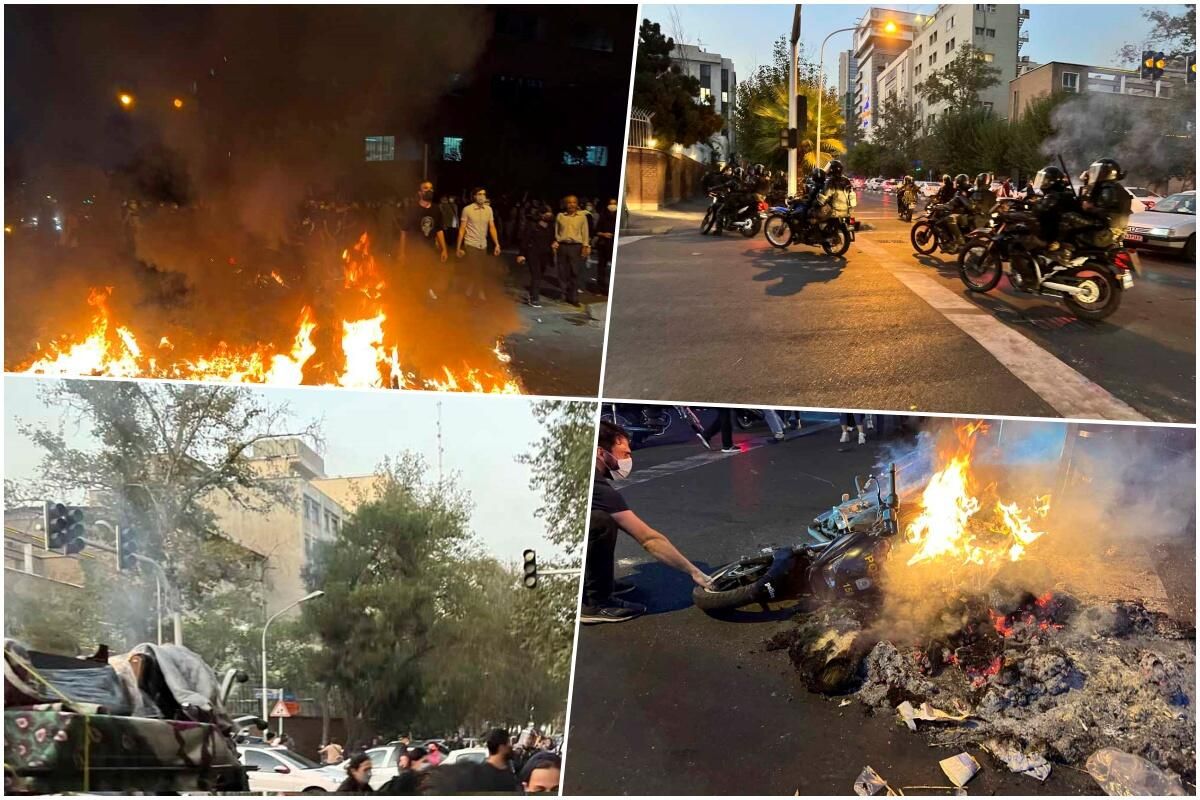
It is the second time since 1945 that the nuclear super powers have been dragged to the brink of the abyss. Despite the differences with events half a century ago there are stark similarities. The one who blinks first loses. And if neither side blinks we all lose.
By Tom Arms
Vladimir Putin is daring the West to blink first.
It is the second time since 1945 that the nuclear super powers have been dragged to the brink of the abyss.
In October 1963 it was the Americans who felt threatened. Soviet missiles were moving into their backyard. This time it is the Russians. No US nuclear weapons are being sent to Ukraine, but Russia claims that Washington is using Ukraine as its proxy to—using Putin’s words—“destroy Russia.” But that is where the reverse parallels end. Ukraine is no Cuba. It is more dangerous.
For a start Putin is not Khrushchev. The Soviet system had many faults. It made no pretense of being democratic and its stated aim was the overthrow of Western capitalism. But one of its strengths was that, in 1963 at least, the Politburo was more of a collective leadership than it is today. There was a party leader, but there were others behind him who held significant influence and could replace him in a peaceful transition. In fact, that is exactly what happened.
Putin is an elected dictator. His stranglehold of the media, the judiciary and the electoral commission casts a huge shadow over the Russian ballot box.
Once elected, Putin’s power is far greater than that of his post-Stalinist Soviet successors. He maintains and dispenses that power with a system that combines old-style feudal fealty with kleptocracy masked by religiously-fuelled populist nationalism. And because Putin is elected he has greater domestic political legitimacy than his Soviet predecessors.
This legitimacy, however, has a price—success. If the Russian President fails to deliver he can be removed more easily than the old communist leaders. And because there is no obvious successor or mechanism for finding one, Putin is more likely to resort to drastic measures to stay in power.
Under Soviet rule, the Russian people were locked into their country behind an Iron Curtain. Today they are free to travel. And they are. In the three weeks following the start of the Ukraine War an estimated 200,000 Russians fled their country. Following this week’s partial mobilization, of reservists all the flights out of Russia were immediately booked solid for days in advance and the roads leading to the borders of neighboring countries were blocked with one-way traffic. At the same time, more than 1,000 anti-war protesters were arrested in two days.
Then there is the weaponry. Both Russia and NATO have nuclear arsenals capable of blowing up the world several times over. What is important is the delivery systems and both sides are better equipped than they were in 1962. For a start, America’s first submarine launched ballistic missiles (Polaris) had only just come into service. Now the nearly undetectable underwater nuclear missile platforms are at the heart of the nuclear deterrent of both NATO and Russia. But Moscow currently has the edge on launch systems.
Putin’s arsenal includes the new hypersonic Kinzhal missile which can travel at 12 times the speed of sound. Moscow claims it is “unstoppable.” The Russians have also deployed underwater nuclear drones called Poseidon which are designed to attack coastal cities and create tsunamis. On land, the Russians new intercontinental ballistic star is the Samat missile with a range of 11,000 missiles. It is silo-based but the Yars can be mounted on the back of a difficult to detect lorry or flatbed railway car and has a range of 7,000 miles. There are more at the strategic, intermediate-range and tactical level.
NATO has also changed since 1962. Europe is still heavily dependent on the US nuclear umbrella, but both the British and French deterrents are far more effective than they were 60 years ago. In conventional terms, NATO has two million troops in Europe against Russia’s million (minus their losses in Ukraine and plus 300,000 in the latest “partial mobilization).
Of greater significance is the political and economic changes in Europe and America. In 1962 Americans were mentally prepared for a showdown with Moscow. In 2022 they are tired of fighting “other people’s wars”, divided politically, more focused on Asia and China and are only just waking up to the fact that the Cold War did not end in 1991. It only paused for a few years.
Europe, for its part now has the European Union which has raised the continent to new heights of prosperity. Both the EU and NATO have drawn most of the former Soviet satellites into their orbit. But Europe has failed to rise to the occasion in military terms and British withdrawal from the EU has weakened the alliance. In economic terms, Europe has allowed itself to become dependent on Russian energy and there is a real fear that this dependence will cause Europe to cave-in. Although Putin’s saber-rattling appears to harden European resolve.
Despite the differences with events half a century ago there are stark similarities. The one who blinks first loses. And if neither side blinks we all lose.
 World Review
World Review
- They are burning their headscarves and police cars in Iran. Persian women are fighting back against the mullahs’ morality police. The catalyst for their anger is the death in police custody of 22-year-old Mahsa Amin. The Iranian authorities claim she died of a pre-existing heart condition. Rubbish, say her family, there was nothing wrong with her heart. She died, they claim, because she was beaten in the police van on the way to the station. Ms. Amin was arrested because she was wearing her hijab or head scarf improperly. That is common offense which the morality police monitor along with the wearing of tight trousers and leggings, holding hands or kissing in public. Iran is not the only Muslim country with morality police. Afghanistan has probably the most severe. Iran probably holds the number two slot. Others include Nigeria, Sudan and Malaysia. Then there is Saudi Arabia where the ruling family’s adoption of Islam’s strict Wahhabi sect led to the establishment of the notorious Committee for the Protection of Virtue and Prevention of Vice. Better known among Saudis as simply “The Committee.” Crown Prince Mohammed bin Salman, however, has been circumscribing the morality police to the point of near extinction. The backlash in Iran may force the Mullahs to follow suit which can only undermine their wider claim to political legitimacy.

Violent protest demonstrations in Iran – Photo Courtesy: Serbia Post - Europe is taking another lurch to the right. This month two national parties with links to a fascist past have either come to power or are poised to do so. Sweden has been known as Europe’s most tolerant country towards cultural diversity. But this month the rabid anti-immigrant Sweden Democrats emerged as the second largest party and is forming a government with the center-right Moderates. In a disturbing echo of Donald Trump, party leader Jimmie Akesson declared it was time to “Make Sweden Great Again.” Georgia Meloni, leader of the Brothers of Italy has an equally upsetting motto which links her party to its fascist past—“God, family and fatherland.” Ms. Meloni is expected to emerge as Italy’s prime minister after Sunday’s vote. Her party is Eurosceptic, anti-immigration, anti-gay, anti-abortion and has expressed doubts about NATO membership. Italy and Sweden join Hungary, Britain, Czech Republic, Slovakia Austria and others who have lurched rightwards. There are differences between them but the one common element is the disturbing trend to portray their country as a victim.
- I have just returned from Iceland and can report that the isolated, sparsely populated land of fire and ice is just as worried as everyone else about Ukraine. The main reason is its strategic location. Iceland straddles what is known as the Greenland-Iceland-UK-Gap (or GIUK). Through this gap Russia’s deadly submarine fleet and deadlier underwater drones must pass to reach the North Atlantic. The GIUK Gap is the reason Iceland is a member of NATO even though its population of 370,000 is unable to support any military. NATO needs Iceland as a base from which to monitor Moscow’s undersea activities and Iceland needs a NATO umbrella. In 1951 Iceland and the US signed a defence agreement which committed America to its defence in return for a monitoring base at Keflavik. At the height of the Cold War there were 5,000 Americans based at Keflavik Air base. Then the Cold War ended. The planes, helicopters and soldiers were needed in Afghanistan. In 2006 the American flag was lowered, the troops disappeared and their facilities were sold to Icelanders at bargain basement prices. Russia’s resurgence, however, has caused a rethink in Washington and some troops and surveillance aircraft have returned. But there are problems with a return to the good old days. The party of the current highly popular Prime Minister Katrine Jakobsdottir wants to pull out of NATO and most of the Keflavik facilities are no longer available. To solve the latter problem Washington is looking at Northwest Iceland for a completely new base. For the second they are being very quiet about returning in order not to upset Iceland’s domestic political apple cart.
- One thing the Icelanders do not have to worry about is the energy crunch. Ninety percent of their energy is geothermal. The remaining ten percent is mainly hydro from Iceland’s many beautiful and dramatic waterfalls. The geothermal energy comes from the hot springs heated by roughly 130 active volcanoes whose molten lava turns the water into scalding steam which turns the turbines in five major geothermal plants. So much hot water is created by Iceland’s volcanic geology that it is pumped directly into people’s home radiators, through under-pavement pipes to keep them ice-free in the winter and into public swimming pools. There are even plans to export their geothermal energy. In the meantime they are just enjoying their low heating bills while the rest of Europe sweats it out.
- The markets delivered their verdict on Britain’s “go-for-growth” mini-budget even before Chancellor of the Exchequer Kwasi Kwarteng finished his speech and sat down. The FTSE 100 plummeted by two percent as investors dumped UK assets. The pound plunged against the dollar to $1.11, only six cents above its all-time low of $1.05 in February 1985. This was the exact opposite of the reaction Prime Minister Liz Truss expected. Her plan is to fight inflation, low growth and low productivity by lowering taxes so that rich people and companies spend more in Britain. It is the Truss version of Ronald Reagan’s trickledown economics. A plan to raise corporation tax to 23 percent has been cancelled. It is staying at 19. Banker’s bonuses are no longer capped and the top rate of income tax (45% for those earning £150,000 or more) is scrapped. The 31 million people (Kwarteng’s figure) at the bottom of the pay ladder will be £3 a week better off which is roughly the cost of 1.5 pints of beer. Those at the bottom of the top end of the pay scale earn about five times as much as those at the bottom but will be 50 times better off when the government’s budget takes effect next April. They will be able to buy a bottle of vintage champagne every day. The tax cuts are being accompanied by up to £120-150 billion of government borrowing to subsidize a cap on energy prices. This at a time when the Bank of England is expected to raise interest rates by half a percent. The hope is that the newly richer will spend the extra cash and stimulate the economy. But trickledown economics have never worked in the past. Neither markets nor most economists think they will work in near-future Britain, especially when the government is borrowing two percent of its GDP.
___________________
 Tom Arms is foreign editor of Liberal Democratic Force and is currently working on an updated edition of his Encyclopedia of the Cold War
Tom Arms is foreign editor of Liberal Democratic Force and is currently working on an updated edition of his Encyclopedia of the Cold War